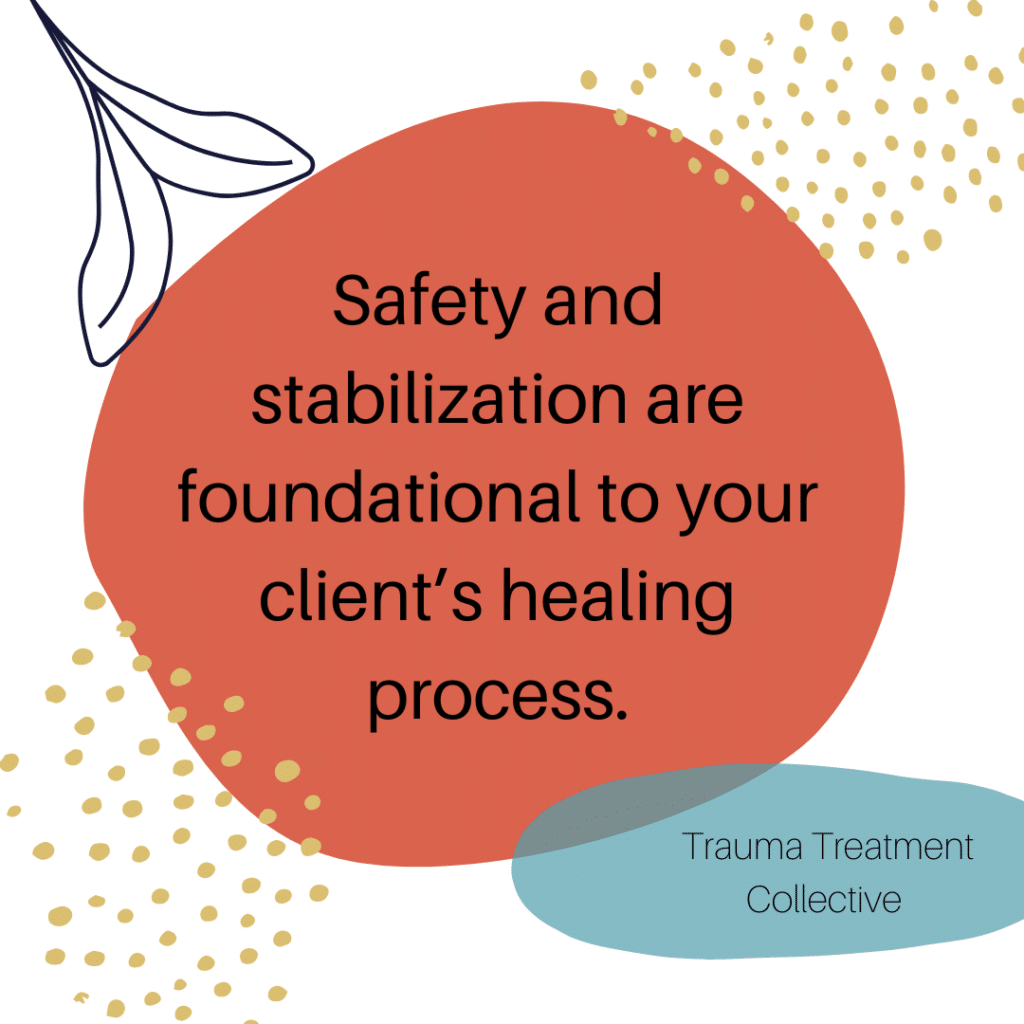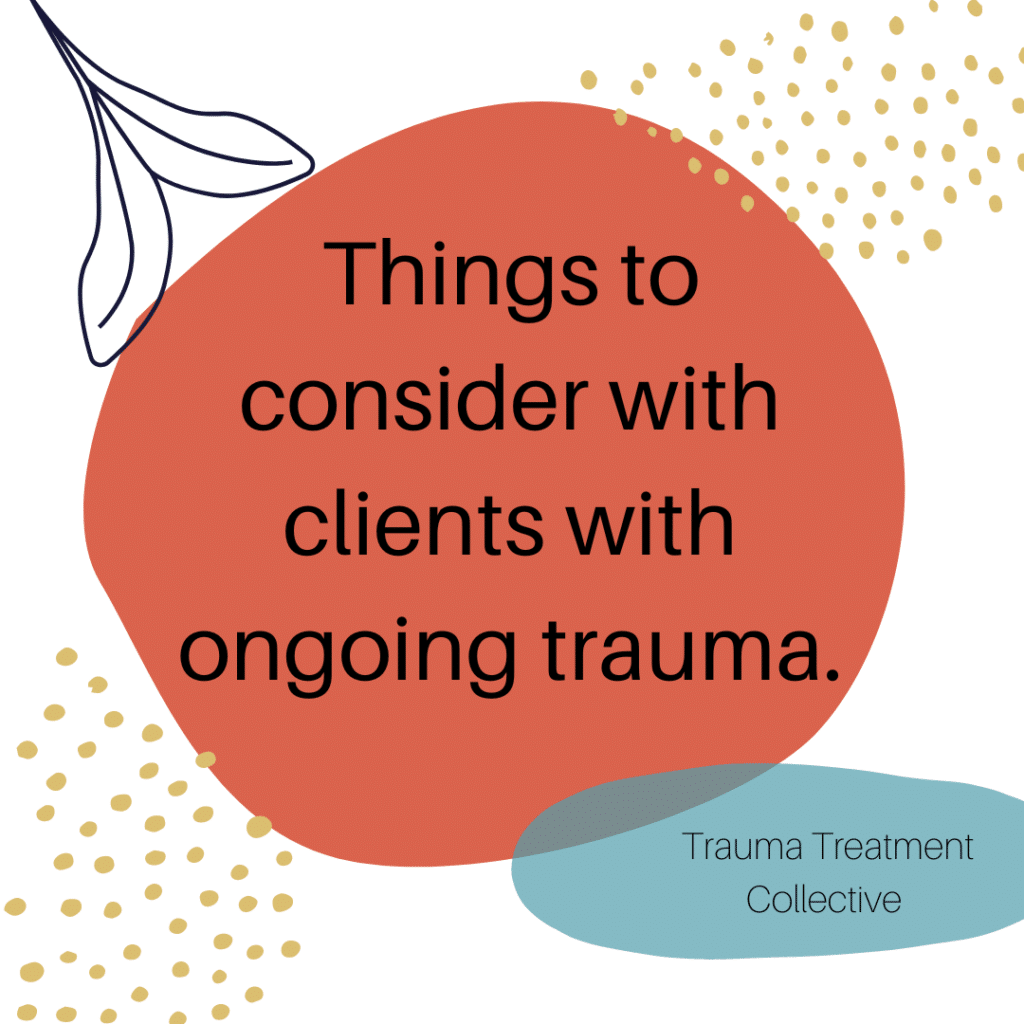Trauma treatment is complex work, and we all have those cases that are harder than others for us. If you are anything like me, one of the hardest cases for me to navigate are the ones where there is ongoing trauma happening to the client.
I only work with adults at this time in my practice, but when I worked with children and families, this was a more common occurrence for me. But no matter your population, I think it is wise to be prepared and think through the way you want to conceptualize these cases. This will help you to navigate the healing journey with a little more ease.
Let’s start with some suggestions around conceptualization. When you look at most trauma treatment modalities, you will see them structured in the same way. They usually refer to phases of treatment. I find this to be helpful due to the complex nature of treatment and the importance of the foundational pieces before moving a client into processing. Over my 19 years as a trauma treatment professional, I have seen many ways of listing the phases of trauma treatment, but they all generally start with safety and stabilization.

When we are working with ongoing trauma, I believe that safety and stabilization are the main focus of treatment. I have consulted with some therapists that feel that they are not doing “good” work or “effective” work when they are only focusing on safety and stabilization. If you also have similar thoughts (or maybe you have never thought about it in that way), I want to invite you to consider that these foundational pieces of work are the building blocks for sustainable healing. They are vital to the clients healing journey.

A couple of things I consider when working with a client in ongoing trauma is immediate safety/ boundaries, client skills, empowerment, and co-occurring disorders. I also am very clear that until ongoing trauma stops, it is very likely that processing their past and current trauma won’t be able to start. I usually also try to explain from a neuroscientific perspective why healing during ongoing trauma is usually not available to a client. This psychoeducation can help a client understand the why and structure behind their treatment, which can aid in the client buying into the process.
Safety
Helping the client create a sense of safety within the therapy room and then helping them to carry that sense of safety into their everyday life is vital to their journey.
One way I really like to establish a sense of safety with the client is education on boundaries. You can watch a clip of me talking about how I provide boundary psychoeducation here. I also have activities to help clients connect to their boundaries or start to establish a connection to new boundaries. The more the clients can have a felt sense of their boundaries, the better they will be able to embody and access their boundaries.
Client Skills
Once safety and boundaries are in place, I help clients to establish some client skills. I first heard of the concept of client skills from Kathy Kain. The skills I focus on developing are a client’s sense of connecting to positive and/or neutral sensations, the ability to notice expansion and contraction, their ability to notice when things are familiar and when things are novel, and overall general regulation skills.
I usually will assess these four skills starting at intake and if I notice clients are proficient in any or all, I will point them out and celebrate their ability to perform that skill. I let them know that it will be useful in their trauma healing journey.
If I notice that a client is needing development in an area, I will focus our attention on the skill development over time and encourage the client to practice the skill outside of session. I am continually assessing to ensure that my clients are able to practice these skills during our time together because these skills make navigating the effects of ongoing trauma a little easier.
Empowerment
While having the skills and knowledge is helpful in the healing process for clients dealing with ongoing trauma, helping clients establish or reconnect with a sense of empowerment is also pivotal to the healing journey. Many of my clients come into treatment “white knuckling it” through or holding on for dear life waiting for what feels like an emotional tsunami to crash onto land.
By helping clients focus on a sense of empowerment, it gives them hope that they are not hostage to the emotional ups and downs or the unexplained somatic complaints. They start to feel like they have a sense of control in their lives. I have found that empowerment can happen in simple ways, like helping a client stabilize and move away from intense emotions and sensations.
Co-Occurring Disorders
As we move through helping clients with all the other pieces, it is important that we don’t overlook any co-occurring disorders that might need attention. Co-occurring disorders can especially be active when a client is distressed from the ongoing trauma. These disorders could be maladaptive coping strategies for the dysregulation clients find themselves in.
There are a number of other disorders that commonly show up with trauma so we won’t get into how to address them all here. But I would encourage you to check out the vlog/blog and podcast to see if there is some information that will help you navigate your client’s specific situation. Overall my goal for this blog post is to invite you to consider how addressing co-occurring disorders could be helpful to clients with ongoing trauma.
Ongoing trauma can be tricky to work with, and it can feel like progress can’t be made in the midst of it. But remember that one safe relationship can be the catalyst for change for your client. I hope these focus areas can be helpful as you help your client navigate ongoing trauma.


2 Responses
Thanks for the refresher, Nina. This was a helpful reminder
Hey, Moya!
You are so welcome. I am glad it was helpful to you. I hope this message finds you doing well!